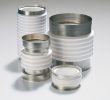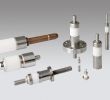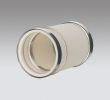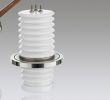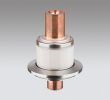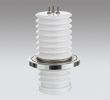Ceramic insulators and bushings
Ceramic-to-metal bonded electrical insulators combine the properties of both materials (metal and ceramic) into a single component. The presence of a technical ceramic such as pure alumina ensures excellent electrical insulation and dimensional stability of the product. The presence of metal provides electrical conductivity (where desired) and guarantees the solderability of the component.
Finally, the soldering between the two materials ensures a totally hermetic vacuum inside the component. These insulators and electrical insulating components are ideal for many high voltage and/or high current applications. They can be used in various forms for industrial applications, applied or fundamental research or in advanced measurement and analysis technologies such as synchrotron.
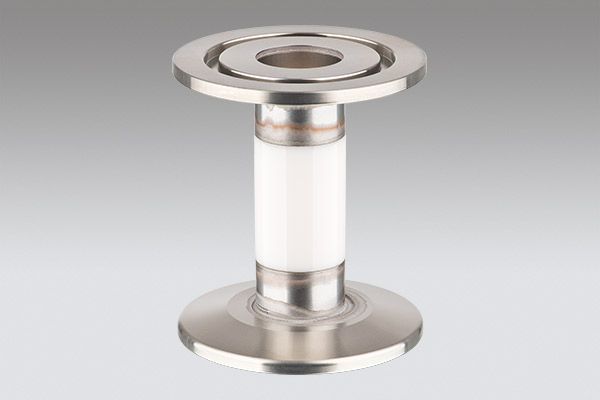
Why choose alumina as an electrical insulating material?
Alumina is a technical ceramic with many mechanical properties and excellent electrical and thermal properties. It is an excellent electrical insulator, even at very high temperatures. It is a refractory material: it can withstand extreme temperatures, up to 1950 °C for example with Kyocera F99.7 alumina (99.7% pure). Its dimensional stability even at high temperatures ensures that components will not deform, even when heated to high temperatures. It is also a material with high corrosion and abrasion resistance which allows it to be used in contact with almost any product or material. The oxide also offers very good wear resistance, which allows it to be used in products with a long operational life. Thus alumina can be used in ceramic-to-metal seals and is an ideal high performance ceramic for electrical insulation applications.
What are the different ceramic insulators we offer?
The products offered are made of Kyocera F99.7 and F99.7 hf (hf = high frequency) alumina for the ceramic part. On request, the metal part can be made of a non-magnetic metal such as titanium, which can be useful in certain fields involving strong magnetic fields.
We offer electrical bushings. They can have one or more metallic conductors allowing different currents (control or power) to flow through electrical cables from one end of the feedthrough to the other. Ceramic provides a reliable separation between media with different potentials, which ensures that currents flowing through the channels will be electrically isolated from each other and most importantly isolated from the outside environment. Ultra high vacuum (UHV) environments place new demands on conventional materials and ceramic-to-metal sealing techniques. These bushings are an excellent example of a ceramic electrical insulator that meets these new challenges. They are ideal for under-vacuum and high voltage applications.
Electrical insulators and insulators are also available. They can be corrugated and their surface can be glazed. The presence of corrugation increases the creepage distance, which allows to reach a higher dielectric strength. The enameling makes the product easier to maintain and faster to clean. Depending on their construction, our insulating tubes can be used for cryogenic applications with helium or liquid nitrogen at temperatures ranging from -271 °C to 450 °C (but their operating temperature remains at room temperature). The dimensional stability of alumina allows measurements with very good accuracy.
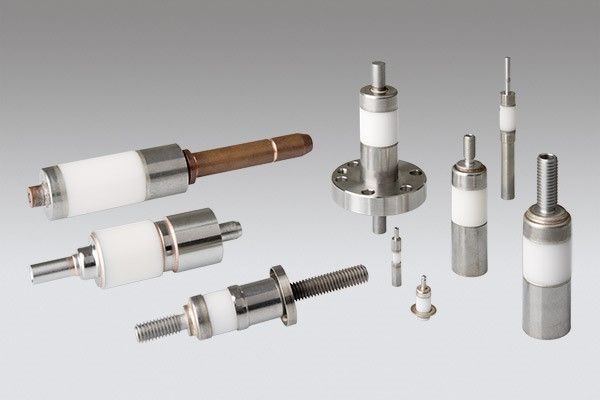
What are these ceramic insulators used for in research?
Ceramic electrical insulators are very often used in research and especially in microscopy. Indeed, electron microscope focusing units require tolerances of only a few µm, which allows samples to be observed with maximum resolution and the greatest possible depth of field. Such resolution and depth of field requires excellent electrical insulation of the individual components, which can be achieved with alumina ceramic thermal insulators.
These ceramic insulators can also be used in fundamental physics and medical research, especially in particle gas pedals (useful in the treatment of certain cancers). The properties of alumina make it an ideal high-performance ceramic for particle gas pedal components, especially for injecting and extracting particles from the gas pedal. The presence of ceramic (rather than metal alone) allows the parts to be usable despite pulsed electromagnetic fields. Ceramic-to-metal seals are impressive in terms of their properties, including maximum electrical isolation and complete hermeticity even under high pressure or ultra-high vacuum environments.
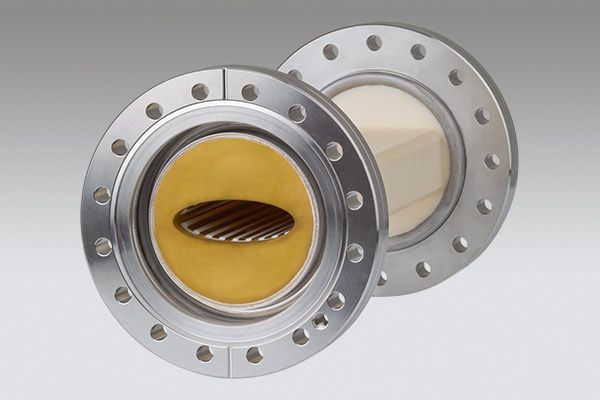
In what other sectors are these insulating ceramics used?
Ceramic electrical insulators are used in many fields that require some of their properties. For example, they can be used for marine and underwater applications. This use shows their interest at high pressure: in spite of high temperatures and a very important pressure, the component remains an electrical ceramic insulator and the joint between the alumina and the metal remains perfectly tight.
These insulators are also used in radiology and medical applications, for example in X-ray technology. Ceramic components ensure accurate and reliable diagnostics and safe treatment for patients.
They are often used in measurement and control technology. Our customers need accurate, reproducible and safe results. Ceramic ensures long-term protection of highly sensitive sensors under extremely demanding conditions.
As electrical insulation is a key property in many fields, our wide range of ceramic insulators is useful in many other sectors such as the semiconductor industry, electrical engineering, particle gas pedals or vacuum or ultra-high vacuum enclosures for applied or fundamental research.





